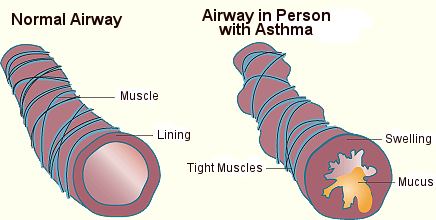When one has breathing problems, their life can become very complicated and even the simplest daily tasks can become a burden. There are many causes of breathing problems and there are ways to control them to some extent. Here are some of the most common breathing problems and advice on how to deal with them.
 COPD
COPD
In most cases, COPD, or chronic obstructive pulmonary disease is a combination of chronic bronchitis and emphysema, although it can sometimes be only one of these conditions. Chronic bronchitis causes tube inflammation, which leads to coughing. Emphysema causes the narrowing of the airways, which makes it difficult for air to enter your lungs and can leave you breathless. In both cases, airflow is limited due to airway damage. This is usually a progressive disease and it shouldn’t be ignored. It is diagnosed based on symptoms and spirometry is used for confirmation. There isn’t a known cure for the disease itself, but the symptoms can be managed by giving up cigarettes, doing appropriate exercises or using supplemental oxygen.
 Asthma
Asthma
This is an inflammatory disease of lung airways. The airways become irritated, which makes them tighten and cause breathing difficulties. The reasons for the airway irritation vary, but asthma is most often triggered by allergens, such as pollen, dust mites or molds. Other triggers are air pollution, certain medications or even an emotional reaction. The symptoms include shortness of breath, coughing and wheezing. It is normally diagnosed by observing a patient’s medical history and confirming the diagnosis through spirometry. Asthma might be controlled by identifying triggers and avoiding them, or by using bronchodilators and certain medications.
Allergies
The most common allergy causing breathing problems is allergic rhinitis, commonly known as hay fever. This is a form of nose inflammation, caused by allergens in the air. Your nose can become runny and stuffy and you could even be sneezing. It is most frequently triggered by environmental allergens, like pet hair, pollen or dust mites. Allergy testing may determine what you are allergic to, the most common form of which is skin testing. Controlling allergies might be achieved with certain medications, or by avoiding the known allergens.
 Apnea
Apnea
Apnea is defined as suspension of breathing. It can be involuntary, drug-induced, mechanically induced, or it can appear during sleep in people suffering from sleep apnea. When the muscles in the back of your throat relax during sleep, your airways can become narrow, or even close up completely, which means you can’t breathe. This is what sleep apnea is. Your brain deals with this by waking you up, but this can happen multiple times during the night and you don’t even have to be aware of it. You can take a reliable sleep apnea test to confirm you suffer from this condition. These tests are quite useful, since there is no way to diagnose apnea with a blood test. Some ways of managing this disorder may be sleeping on one’s side, losing extra weight, wearing certain masks while sleeping, or even surgery.
 Sinusitis
Sinusitis
Sinusitis is the sinus inflammation, which can be caused by viral or bacterial infection, allergies or even air pollution. Although the most common symptoms are headaches, it could also cause breathing problems, due to the thick nasal discharge which plugs the nose. Coughing can also be a common symptom. It can be diagnosed by observing the patient. If the sinusitis lasts less than 10 days without the symptoms getting worse, it’s probably viral. If the symptoms last longer than that, or if they get worse during that time, the infection is considered to be bacterial. The treatment may include antibiotics, corticosteroids or surgery.
If you notice you have trouble breathing, you shouldn’t waste your time, since this may mean you have some serious health issues. In case of breathing difficulties, it is essential to visit a doctor, find out what causes the problem and treat it accordingly.
Guest Blogger:
Mia Taylor, mrsmiataylor@gmail.com, www.highstylife.com

